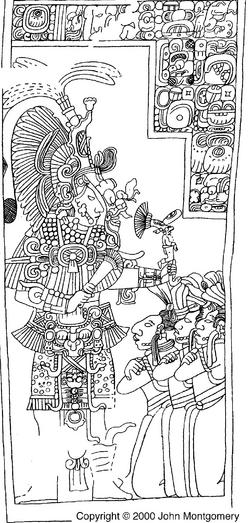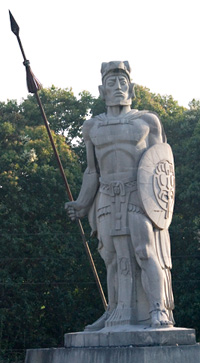Ilok'tab Dynasty
| 12th Dynasty Ajaw-Ilok'tab Nimja | |
|---|---|
 The Dynasty kept the Glyph of Sakule, the capital of the Mam Kingdom, as their Glyph-Emblem | |
| Parent house | Ilok'tab |
| Country | |
| Founded | AD 1205 |
| Founder | Jasaw Chan K'awill III |
| Current head | Jasaw Chan K'awiil V |
| Titles | |
Origins and history
The Ilok'tab Dynasty, is an Ajaxi royal house and one of the three clans that founded and ruled over the Kingdom of K'umarkaj in 875 CE, with the Numa K'iche and the Tamub Houses. As such, they were an important Nimja, "Great House", of the K'iche and its members had numerous roles in both the military and the civil administration of the kingdom.
The Ilok'tab were one of the three most important lineages in the K'iche Kingdom, alongside the Numa K'iche (not to be mistaken with the ethnies itself) and the Tamub'. The K'iche appears in history during the 9th century CE after their conquest of the Chujuyop Valley in south-east Mutul and the foundation of their first capital Xakalwitz. The Ilok'tab were then a powerful family of generals and warriors, with most of the highest-ranking officers of the Ajpop, the King, army being recruited from their ranks. The House itself was divided in multiple lineages, the most important of which were the Sik'a' and the Wamja.
After the conquest of the Mam Kingdom by the K'iche, it was offered to the Ilok'tab to become a vassal principality under the Ajpop's rule. The Mam heartland would remain the core possession of the Ilok'tab House until their rise to the Divine Throne, two centuries later. Achik' Nim Banik, Patriarch of the Ilok'tab during the early 11th century, was thus Mukwitz Tzik Winak (Count of Mukwitz), Mam Ajaw (Ruler of the Mam people), K'iche Alaxel (Prince of the K'iche), and Nakam Pop (General of the Mat or High-Marshal).
Achik' Nim Banik's first son, Ban Kache, inherited Mukwitz and rank as one of the Ajpop's Four Generals, ensuring him a comfortable position at the royal court. His second son, Nim Chamiy, inherited his prerogative as Mam Ajaw. In 1030, Ban Kache joined a revolt against the Ajpop, while his brother remained loyal to the king. After the victory of the loyalists and to reward him for his support, the Ajpop made Nim Chamiy, now patriarch of the Ilok'tab after his brother's death, his new High Marshal. an honor that would also be granted to his son K'ak Chamiy. They did not however, herited back the town of Mukwitz, probably by design as it allowed the Ilok'tab to focus entirely on their duties in the Mam Heartland.
The 8th of May 1094, K'ak Chamiy was present at the corronation of K'ukumatz as K'uhul Ajaw. Himself and his childrens inherited many titles and positions at the new court of the Nima K'iche Dynasty. However, the Dynasty was short-lived : K'ukumatz died in 1099 during a battle against the K'oja People who had rebelled against the K'iche. The revolt was put down by his son, K'ikab. But in 1109, ten years after his crowning, two of K'ikab sons and their vassals rebelled against their father. This first rebellion ended in a defeat of the royalists and a strengthening of the aristocratic lineages and a re-negociation of K'ikab inheritance. But the death of his first son, Waxak, before he could inherit the throne, led his two brothers and their respective partisans into a fraticidal war for the throne. K'ikab, then terribly ill and dying, agreed to follow his non-K'iche courtesans' advises and summon a large noble council, in which Xiu Tzik'in, Patriarch of the Ilok'tab, King of the Mam, and General of the East, participated. The Council decided, following the previous dynasties' customs but against K'iche's traditions, to elect Tziawilix the K'uhul Ajaw's daughter as K'uhul Ajaw. In the ensuing succession crisis, Xiu Tzik'in was instrumental in the defeat of the two brothers and the re-conquest of K'umarkaj and the southern regions. After K'ikab's death in 1114, Xiu Tzik'in succeeded him in a purely legal manner as she was his last living descendant. Her own son : Oxib Keh, inherited her position in 1142 but since the K'iche are a patrilineal people, he is considered to be the founder of the Tamub Dynasty.
During the Tamub Dynasty, the Ilok'tab continued to enjoy great prestige : they cumulated a great number of titles and courtly positions. Xiu Tzik'in's elder son, k'ak Kantun, was notably King of the Mam and Marshal of the East, while his brother was King of Oxwitik. Their sons all served under one another as civil lords of various cities and districts, or commanders of fortresses.
In 1198 the Tamub K'uhul Ajaw B'ah Chich, was only seven years old and showed signs of mental deficiencies. A council of regents was put in charge of the country. Tecuman was one of the regents elected by the noble council, but through political manoeuvering and court intrigue and managed to sideline all the other regents. In 1202, B'ach Chich died after a mental health crisis. The same year, Tecuman, who was the uncle of B'ah Chich and thus had the "Blood of Chaak", was elected by the noble council as the new K'uhul Ajaw. Breaking away with some K'iche traditions, he renewed with the custom of regnal names, being crowned as Jasaw Chan K'awiil III.
The first Divine Lords
Jasaw Chan K'awiil III
One of the first action as Divine Lord Tecuman-Jasaw Chan K'awiil was to declare war to the Kayamuca Empire which had been in a period of decline for the past century-and-an-half. In the first campaign in 1203 while he couldn't take the Kayamucan colonies in the Xuman Peninsula, he managed to greatly reduce the area they effectively controlled and obtained a large payment in exchange for a truce. Diplomatic missions in the following year managed to gain him the effective payment of an annual tribute from the Xuman colonies, de facto taking them away from the Yevdinehi's influence. Between 1205 and 1211, he conquered Lakamja River Valley which was then the border region between the Mutul and the Kayamuca Empire. He notably managed this feat by damming the Lakamja river, making it impossible for the Kayamucan reinforcement to supply their besieged vassals of Yarumela and Kelpa.
Jasaw Chan K'awiil III conquests were used to justify his internal politic of reinforcing the power of the central government. While he continued to grant Nimjas with lands and responsibilities in his government, he also doubled the standard administrative structure with a system of Commanderies both in the recently conquered areas but also in border regions and in the old K'iche Kingdom. He also made extensive use of Inspectors and travelling Judges. As such, by 1220, the Mutul had four distinct first-level administratives jurisdictions : the Yajawil (a "Province" or "vassal kingdom"), the Commandery (for the Millitary and Law Enforcement), the Mission (for Inspectors), and the Circuit (for Judges).
The K'uhul Ajaw was helped in his goal by the steady rise in the number of scribes loyal to the K'iche rule. Jasaw Chan K'awiil notably remain famous for his propaganda renewing with the previous dynasties imageries. A propaganda in which his change of name and his patronage of non-K'iche artists and scholars took part in directly. Nonetheless, K'iche Nimjas remained favored above others at the Court and the highest echelons of society, even if they not always agreed or supported his policies.
Yaxk'in Chan K'awiil II
Jasaw Chan K'awiil's son, Yaxk'in Chan K'awiil II, continued his policies. He secured their recent acquisitions, and installed more administrative reforms, giving more powers to inspectors, notably when it came to tax collection, harmonizing the titles hierarchy, and continued to create new Commanderies. In his propaganda, he made regular use of the motto "Harmonizing the Earth to Satisfy the Heavens". Culturally, he continued his father work of "Mutulizing" the K'iche, while keeping Great Houses of K'iche origin at the top of the social ladder.
Contrary to his father, Yaxk'in did little conquests. His generals quelled many rebellions, both in the east and west, but his rule is mostly remembered for his architectural projects such as the densification of the Causaway network linking cities together, the restoration and construction of new canals, aqueducs, temples, and other buildings. The superiority of Inspectors, who supervised the construction to make sure that the budget allowed by the Divine Throne was used correctly, over the Yajawils, who were in charge of adapting Yaxk'in's global plan to the local level, was affirmed through this enterprise. To help with the gestion of his kingdom, Yaxk'in also organized the first census of his Dynasty.
Tecuman
Contrary to his father and grandfather, with whom he share his name, Tecuman, third K'uhul Ajaw, did not take a Regal name, which is explained by the political situation of the Court at the time, divided between the Mutulized and traditionalists factions of the K'iche aristocracy.
Beyond his court intrigues and plotting, Tecuman is remembered for being the K'uhul Ajaw during the Belfrasian Crusade. He notably used the war as an occasion to densify the network of Commanderies, as a way to improve the recruitement of his army for the counter-crusade but also for future conflicts. While he did not raise taxes, he did change the way they were perceived through the Intendents, de-facto raising the quantities perceived and received by the Throne.
The Norumbian Crusade ended up with the signature of a peace treaty with the Latin Empire that was an official recognition of each others area of influences and a division of the Kayamuca Empire between the two. Tecuman ended up having to sign that treaty to conserve some form of benefits from the war while the Mutul was in the middle of a crisis, as an ongoing epidemy made raising further manpowers and funds for the war impossible. Once back to his realm, Tecuman took immediate action against the epidemy in a vast effort of public health. And while the efforts of the Divine Throne proved to have minimal effects, mostly slowing down the spread of the epidemy, the full intervention of the State in the crisis did as much to solidify Tecuman's tax reforms, albeit accompagnied with regular census from the Yajaws checkd by the Inspectors, as the war did. Finally, both the war and the plague forced an important re-organization of the Mutul's society and economy.
The stabilisation of the Mutul after this crisis took time and ultimately, Tecuman was unable to press forward his claim on what was left of the Kayamuca Empire, letting the Runakuna take their own share of the dying Empire, and leaving his successors to finish most of his plans of expansion.

